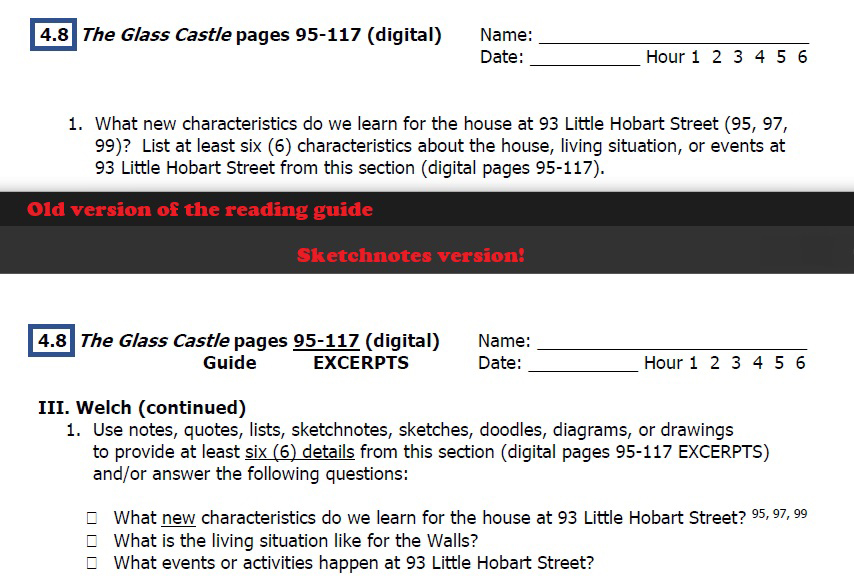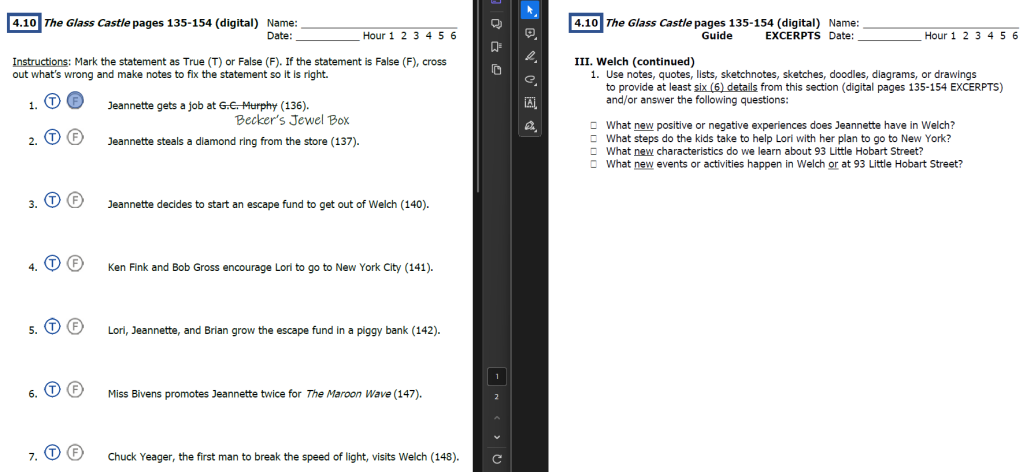Written by Jenni Lamb, 11th grade ELA teacher for Livonia Public Schools
A Struggle with Engagement
In a post-pandemic world, my students often rush through assignments, filling in reflection and comprehension questions with nonsense answers they mindlessly searched on the internet (or worse, had AI write for them). They joylessly slog through even the most high-interest texts in our curriculum and opt out of most enrichment activities if they require interaction with other students. Yet, one new task, sketchnoting, brought about a remarkable change. It stopped them in their tracks this spring, sparking a newfound engagement and understanding!
Discovering Sketchnoting
Through the REMC Doodle For Your Noodle “PL In A Box,” I uncovered multiple ways to incorporate more visual learning into my classroom. Dual Coding Theory tells us that humans remember information better when presented with visual and verbal components; however, with high-stakes testing and increased pressure for data, I seemed to have forgotten to give the arts their fair share in my English Language Arts curriculum.
Implementing Visual Learning
I began the week of the SAT by showing my five junior classes the Graham Shaw TedX Talk, “Why People Believe They Can’t Draw – And How To Prove They Can.” Following a lengthy morning of SAT testing, my students were burnt out and wanted to sleep or skip the afternoon classes. Instead, we decorated cards with our names in fancy lettering, learned basic sketching skills, and ended the hour by tacking hilariously accurate cartoons of ourselves to a bulletin board. It probably helped that I played along every class and made my own cartoon, proudly displaying mine with the kids. Nearly two months later, students still stop at the bulletin board and point out their cartoons to others or comment on one they hadn’t seen before!
Transforming Reading Guides
Since this class period with sketching started with groans and ended with giggles, I took it a step further. I converted reading guides for The Glass Castle to incorporate sketchnoting. The switch was so jaw-droppingly simple I could not believe I’d never thought of it before. I simply changed the instructions from “list [details]” to “use notes, quotes, lists, sketch notes, doodles, diagrams, or drawings to provide [details]” (Photo 1). With some modeling, the juniors easily caught on to the concept. Students went from painstaking notes (many incorrectly copied from the internet), which took me hours to grade in previous years, to wonderful little doodles and sketches that showed me, at a glance, who had read and understood this section of the book.

I was so impressed with the engagement and enthusiasm that mere doodles infused into our fourth marking period that I switched out another reading guide for more visual note-taking. I revised a true/false guide, prompting students to identify and correct untrue statements using information from the memoir (Photo 2). Over the last few years, despite practicing this reading guide style together throughout the novel, students stop “fixing the false” answers and begin losing points in the book’s second half. The sketchnotes were just what we needed to breathe some life into the unit. I even caught a handful of students who cheated when they drew an item that doesn’t appear anywhere in The Glass Castle, let alone that section of the book! Another kid drew smiley faces as the [incorrect] answer for every question, which still felt much more pleasant than AI-babble or copied answers that ran through the “telephone game” too many times.

Measuring the Impact
The silly cheating and swarm of smiley faces were outliers though. Anecdotally, I had the sensation that sketchnoting was both easier for most students to demonstrate their understanding as well as easier for me to grade, but I wanted to see if this was just a feeling or supported by data. I compiled the average reading guide scores into a spreadsheet to see if there was truly a “sketchnotes bump” in percentages. In three of my five sections, the assignments with sketchnoting merited a 4-14% boost over the average scores for the true/false guides. In fact, only my first hour did not see a bump (Photo 3). This data-backed evidence should give you the confidence to try sketchnoting in your own classrooms!

Of course, many factors can account for the positive and negative numbers. My second hour is a co-taught course where 14 students have IEPs, and seven more students receive ELL services. My co-teacher and the ELL teacher have been absent due to state testing. My grade book counts unsubmitted work as zeroes. My fourth hour has B lunch. I made new seating charts. The weather got warmer. Some of my courses meet the same hour as the advanced art courses, leaving large groups of students who believe they cannot draw no matter what Graham Shaw taught us in the TEDx talk. I also tried excerpting some sections of the text and even created a Sesame Street-style “one of these things is not like the others” visual reading guide for the book’s last section – but that’s a blog for another day!
Encouraging Experimentation
Overall, encouraging students to doodle in their reading guides was fun and educationally beneficial. For anyone skeptical of how meaningful this small change can be in your classroom and curriculum, I suggest you think of it like an experiment. Commit to just one lesson incorporating sketchnoting and student-created visuals to see how it positively affects the learning outcomes in your course and curriculum. Build on that enthusiasm and engagement to adjust additional lessons as the unit continues. Tweak your activities or instructions to allow kids to demonstrate their knowledge better. Sketchnoting is a beautiful way for students to slow down and enjoy learning.
Enhance Your Teaching with Sketchnoting!
Are you ready to transform your classroom with the power of sketchnoting? Sign up for the Doodle for Your Noodle “How to Draw to Learn (for Non-Drawers)” program! Back for another year with 3 cohorts available, this program is open and free to Michigan educators, provided courtesy of the REMC Association of Michigan.
Cohort 7: July-Sept 2024
Cohort 8: October-December 2024
Cohort 9: February-April 2025
Grab your spot soon as they went quickly last time! Register here.
About Our Guest Blogger
Jenni Lamb is completing her 18th year of teaching in Livonia Public Schools, currently teaching English Language Arts 11. She is certified in English, German, and ESL/ELL through her two Bachelor’s degrees at Michigan State University and Special Education through her Master’s degree at Oakland University with a dual endorsement in learning disabilities and emotional impairments. She is currently the Information Services Director for the Livonia Education Association. She has previously served as a Region 2 Delegate for the Michigan Education Association as well as on the Resolutions Committee for the National Education Association. When she’s not teaching or advocating for public education, Ms. Lamb spends her time helping her 2-year-old niece achieve early literacy milestones and brainstorming ways to make her four cats go viral on the internet.
#Sketchnoting #VisualLearning #StudentEngagement #CreativeTeaching #EducationInnovation #WeLeadLearning #KentISDpd
This blog post was written by Jenni Lamb, 11th Grade ELA teacher for Livonia Public Schools and edited by Amanda Walma, T&L Marketing and Communications Professional for Kent ISD. Doodle for Your Noodle Sketchnoting course was led by Sarah Wood, Education Technology Consultant for Kent ISD.

